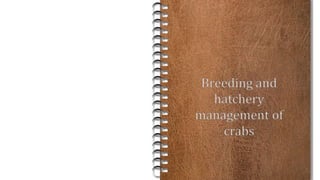
crab ppt.pptx
- 2. PAGE 01 Why crabs farming? • Commercial significance as food organisms. • The crab meat is having high export value and highly relished by foreigners. • Resistance to diseases in culture. • Survival outside the water in case of emergency. • Tolerance to wide range of temperature & salinity. • Scylla serrata mainly cultured for its meat rich chelate legs. • Crab meat is sweet and tasty . • It also have medicinal value and used to cure various protein deficiency diseases. • Crab meat has 20% protein , 5%fat , 2% Minerals , vitamins A and D , glycogen and free amino acids so it has high demand as a table food all over the countries.
- 5. PAGE 05 PAGE 04 The mature female releases a chemical attractant (pheromone) in to the water, which attract males. • The successful male picks up the female and carries her around for several days until she molts. • Copulation can occur only when females are in soft shell condition • Male deposits Spermatophore inside the female storage sac (spermatheca) by using male first pleopods. • The Spermatophore can remain viable, until fertilization takes place, for weeks or even months. pheromone Male Female
- 6. PAGE 05 PAGE 04 • Generally, mating lasts for one or two days, a period which may vary from nine hours to three days. • Mating occurs mostly at night, especially at the beginning of the high tide. • For mating to be successful, water temperature should preferably be higher than 18°C. • Both female and male crabs do not feed during the mating period. • After mating, females consume a large amount of food to support rapid ovarian development. • Under suitable conditions, ovulation may take place 30 to 40 days later Mating of crab:- Normally, spawning occurs early in the morning, between 5:00 -8:00 am. • Eggs are released from the aperture genitals to meet the sperm released from the spermatheca. • Fertilization is internal. • Fertilized eggs stick to the bristles of the abdominal legs of the female which is then called a “berried” or “ovigerous” crab. • Fecundity of Scylla tranquebarica is 2-3 million and of Scylla serrata is 0.5 – 2.5 million.
- 7. PAGE 05 PAGE 04 • Generally, mating lasts for one or two days, a period which may vary from nine hours to three days. • Mating occurs mostly at night, especially at the beginning of the high tide. • For mating to be successful, water temperature should preferably be higher than 18°C. • Both female and male crabs do not feed during the mating period. • After mating, females consume a large amount of food to support rapid ovarian development. • Under suitable conditions, ovulation may take place 30 to 40 days later Mating of crab:-
- 8. PAGE 05 PAGE 04 BREEDING TANK:- a sandy substratum should be provided in the spawning tank. ❑ Half of the broodstock tank can be provided with 10 cm sand layer and another half can be bare floor for feeding purpose. ❑ Alternatively sand filled trays can be provided. ❑ Crabs can be stocked at the rate of 1-2 animal per sq.metre HATCHING • With the development of the embryos, the colour of eggs varies from bright orange, to grey and to dark-grey. • When all the eggs get the dark grey colour , it indicates that the larvae will hatch soon. • The duration of the incubation period depends on water temperature
- 9. PAGE 05 PAGE 04 LARVAL DEVELOPMENT:- • The phototaxic behaviour of the zoea larvae is used to collect them. • Rearing tanks where stocking density varies from 20,000 to 50,000 per cubic metre. • There are five zoeal stages passing through five molts to reach the megalopa stage. • Zoea to megalopa 15 – 20 days (Each moult 3 – 4 days) • The megalopa takes 8 - 11 days before it molts into the first crab stage • The megalopa larvae gradually adapt themselves to a benthic life
- 10. PAGE 05 PAGE 04 Culture techniques:- • Culture techniques have been developed for two species of mud crab Scylla serrata and Scylla oceanic ( available in mangrove and estuarine areas of Andhra Pradesh). • Crabs are cultured in ponds or mangrove pens. • The basic design of most earthen ponds used to culture mud crabs is the same as that used to culture marine shrimp. • In many parts of Asia, where the profitable culture of shrimp has been affected by disease or low prices, have been converted to mud crab ponds. • The mud crab attains sexual maturity in the period of 5 months. • About 5 months after hatching pair formation occur between male crab and female crab. • After Few hours mating occur. • During mating male deposit sperm in the female. • Sperm fertilizes the different batches of egg released by the female. • After fertilization , fertilized egg attach to the abdomen of the female.
- 11. PAGE 05 PAGE 04 Berried female is transferred to the spawning pond. • After spawning the larva hatch out as first zoea stage and then metamorphoses into 2,3,4 & 5 zoea stages. • Then fifth larval stage of zoea metamorphoses into megalopa stage. • Megalopa metamorphoses into juvenile stage • Phytoplankton , chlorella is commonly used for feeding the zoea where as brine shrimp nauplius is commonly used for feeding the megalopa stage • Megalopa metamorphoses into juveniles which are then transferred into the nursery pond as a seed stock
- 12. THANK YOU